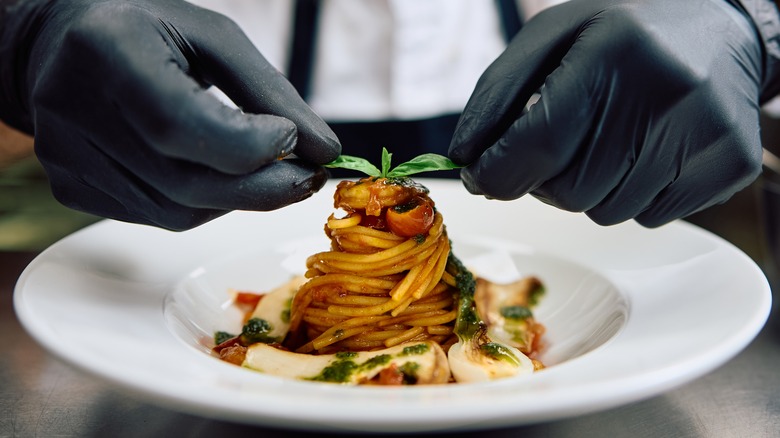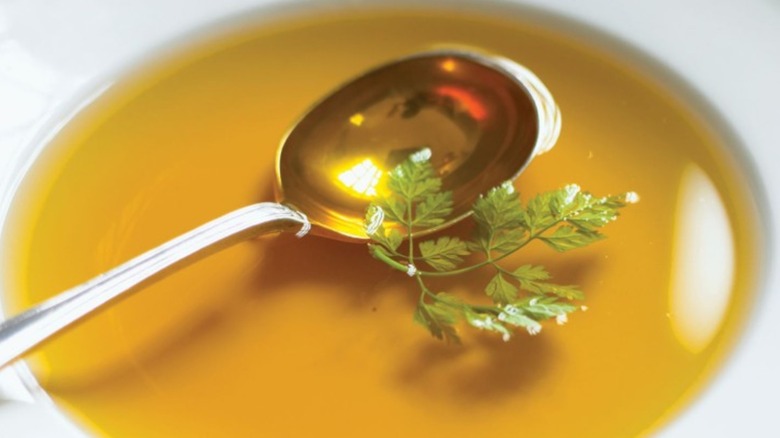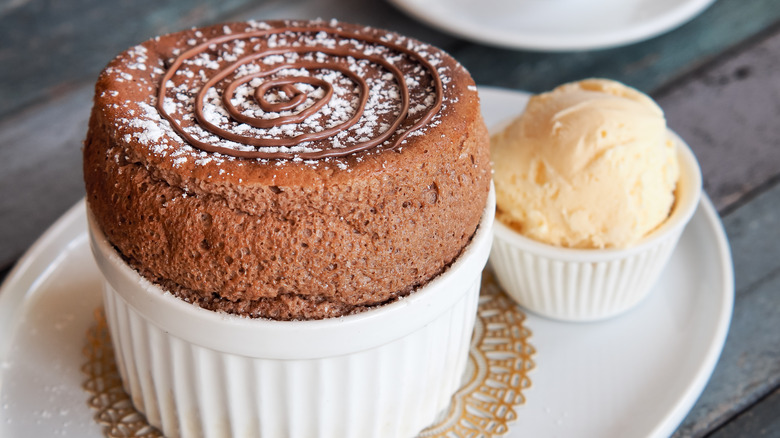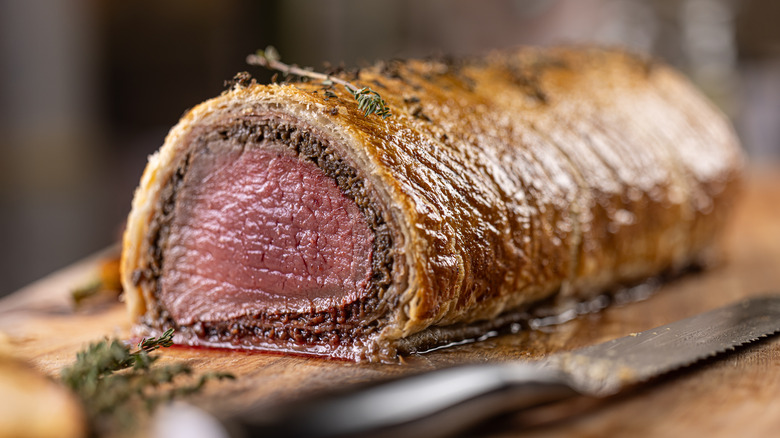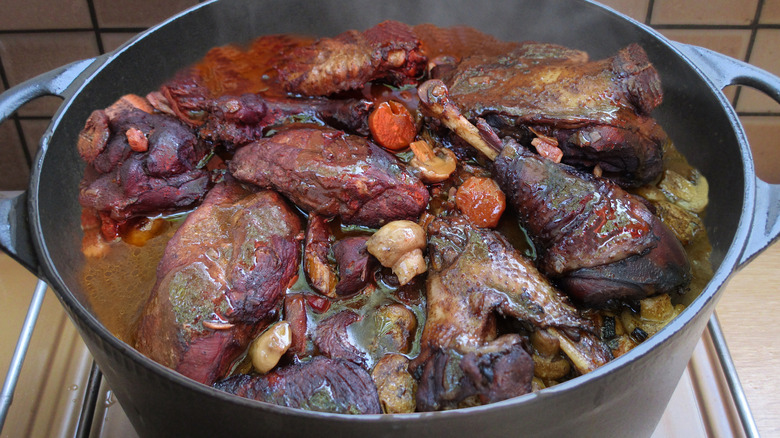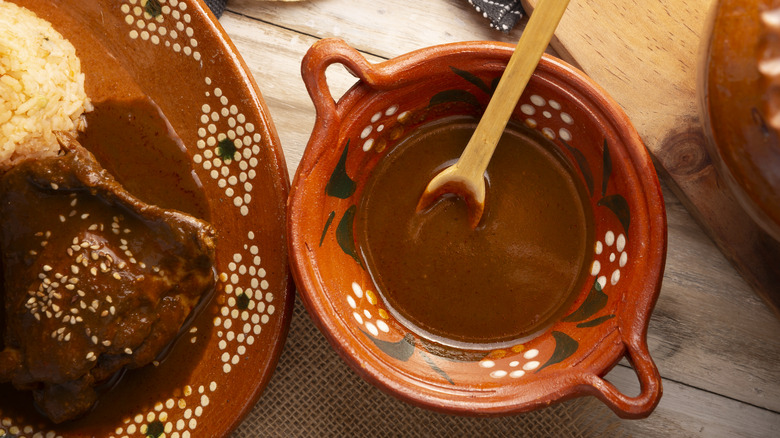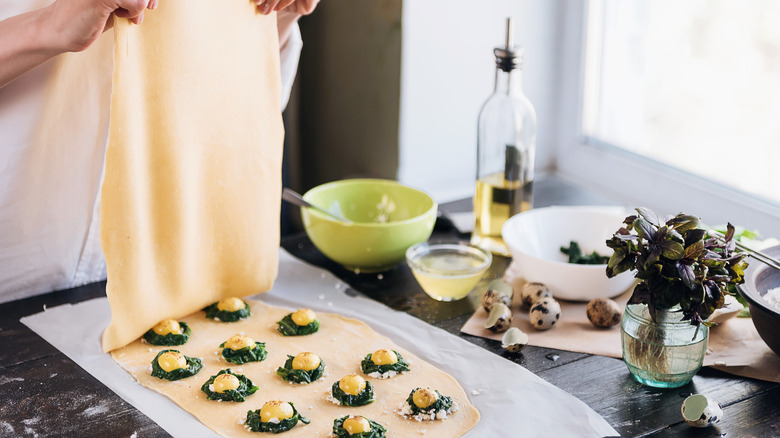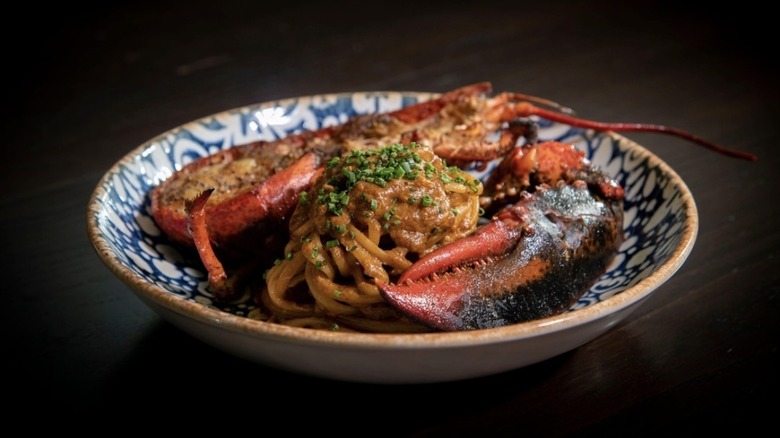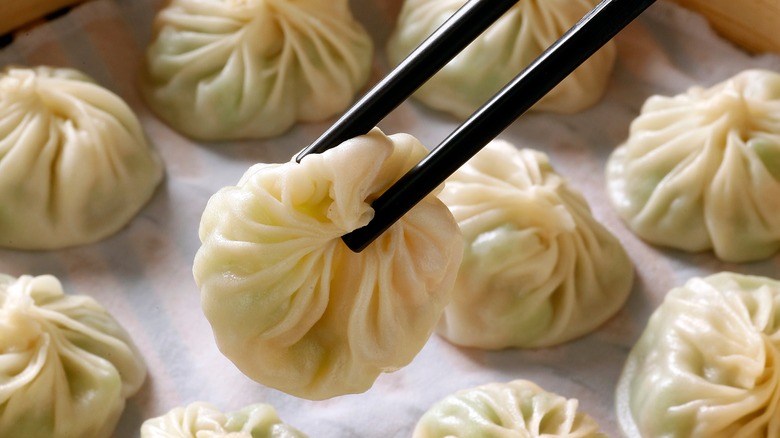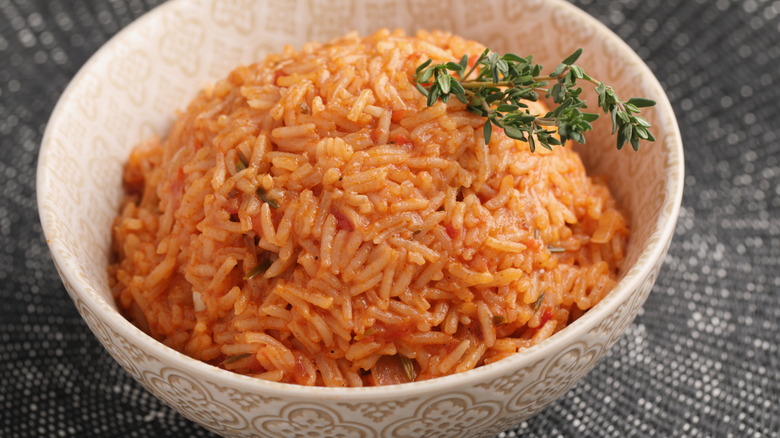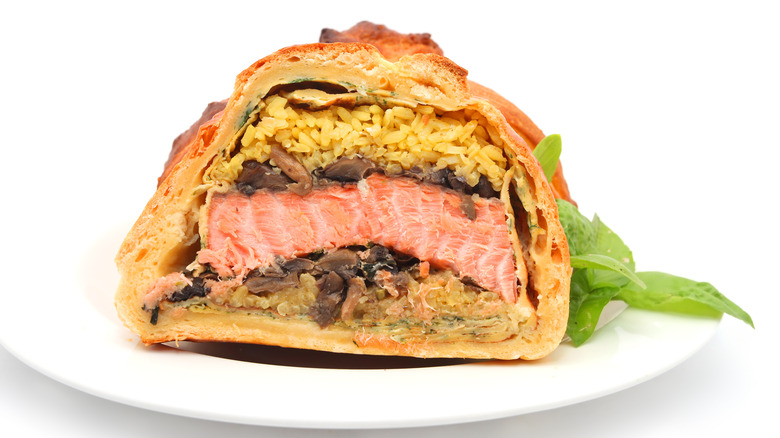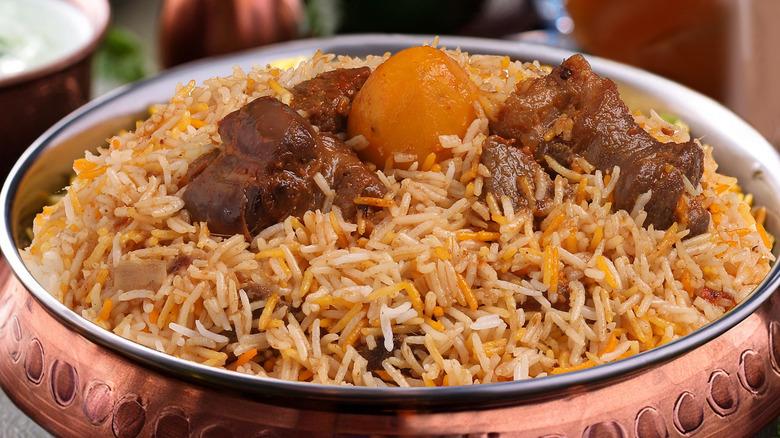14 Of The Most Difficult Dishes To Cook From Scratch, According To Chefs
We may receive a commission on purchases made from links.
The 21st century is an amazing time to be a home cook. Between well-stocked supermarkets and the internet, there is almost unfettered access to incredible ingredients from around the globe. Nor do we have to be a certain age to start learning. Julia Child began cooking at 31, while Bobby Flay and Ina Garten are still kicking it in the kitchen in their sixties and seventies.
Anyone bitten by the cookery bug probably has lots of books that flop open at their go-to recipes, or treasured scraps of paper with recipes scribbled on. They know it takes more than just ingredients to make good food. Cooking from scratch also requires organization, precision, technique, patience, and the knowledge that what works perfectly once could be a disaster the next — even though you did nothing different.
Those same home cooks will keep going back to those dishes, because practice often does make perfect. But which ones test the skills of even experienced professionals? We asked chefs William Dissen, owner of The Market Place Restaurant, Jim Giberson, co-founder at Tamarind Heads, Julie Marble of Levy Restaurants, Artsquest, and Jacob Stull, owner of Rêve, for their thoughts on some of the most difficult dishes to cook from scratch.
Consommé
A stock or broth is the foundation for stews, sauces and even the most lackluster soups, but French chefs took it to a whole new level, thanks to King Louis XIV. The Sun King wanted to see his own reflection in his bowl of soup and, with the crystal clear consommé, his wish was granted. For Jacob Stull, consommé is one of the lost arts of cooking and the ultimate test of a chef's skill.
"It demands precision, patience, and a deep understanding of technique," he said. "But when done right, it yields something remarkable — pure, refined, and rooted in centuries of culinary history." As far as William Dissen is concerned, the real work is in the creation of a proper "raft" on the stock.
Egg whites are used to create a net that holds meat, finely chopped vegetables, known as mirepoix, tomatoes, and spices on top of the stock, before it is skimmed off to a clear soup behind. It looks easy, but Dissen said, "If the pot is not watched during the cooking process, the "raft" can break and make the soup cloudy. It's an act of patience to prepare a proper consommé."
Soufflé
Some dishes look so simple that they couldn't possibly be any trouble for a competent home cook. Take the soufflé, for instance. It's just a combination of eggs and other ingredients — how hard can it be? Well, the answer is pretty darn hard, especially if you're among those who have beginner's luck and get it to rise the very first time.
Soufflés take time and patience, and the devil is in the details. When separating the egg yolks and whites, it's crucial there isn't a spot of yolk in the white, or the delicate chemistry that causes the whole thing to puff up will be unbalanced. Don't forget to coat those ramekin insides with butter and sugar or cheese to help it "climb."
The yolks are blended with the other sweet or savory ingredients before everything is folded into the beaten egg whites, poured into ramekins and baked. Here's where potential danger lurks, according to William Dissen. "If the oven is not heating evenly then it can cause the soufflé to "fall," he warned. If everything goes well, you'll have a light, delicious creation. If not, you can always call it an omelet.
Beef Wellington
We have the ancient Greeks to thank for wrapping meat in pastry, but they probably didn't have anything like the beef Wellington in mind. Created to celebrate the first Duke of Wellington's 1815 victory at Waterloo, Gordon Ramsay is among this dish's most ardent fans. If you've never eaten or cooked it, beef Wellington comprises a sirloin covered in duxelles mushrooms, all encased in puff pastry.
If it sounds complicated, that's because it is. Anyone looking to take on this culinary classic needs a good knowledge of savory cooking, baking, and knife work to get the best results, according to Jim Giberson. The first part is the meat, "Seasoning and searing the beef filet is key to achieving perfect medium-rare from start to finish," he said.
Chopping mushrooms might not sound taxing, but solid knife skills are needed for a duxelles, so you get finely chopped fungi and not mush. Finally, there's the puff pastry. It takes time to make from scratch and has to completely cover the beef and duxelles, before being baked, which requires perfect timing and a calibrated oven
Coq au vin
In Julia Child's book "Mastering the Art of French Cooking, Volume I," she cooks chicken in red wine for around 30 minutes. That's a fraction of the time coq au vin really needs, according to Jacob Stull. He admits he got the recipe wrong at least half a dozen times before it clicked. "Most braises rely on a small amount of wine and a larger amount of stock, but coq au vin flips that," he said.
The traditional recipe cooks a whole chicken (though thighs or full legs work, too) in red wine with herbs, garlic, and bacon. The chicken is then removed and the sauce thickened, before the meat is put back, and the dish is served with pasta or potatoes. The key, as with all marinated meat, is how long it stays in the red wine, and there's some solid science behind it. Stull recommended setting aside at least two days before, "Just like good Southern barbecue, you have to let it cook low and slow, and then let it rest."
He adds depth of flavor to the coq au vin sauce by adding caramelized onions, similar to a sauce lyonnaise or bitter dark chocolate, giving it the rich feel of a mole. "It's subtle, almost undetectable, but it binds to the protein in a way that makes the dish feel luxurious without losing its rustic soul," he added.
Mole poblano
There are many reasons a particular dish might be considered difficult. Some need near-professional expertise, others take lots of time and patience, or need a vast range of ingredients. The latter is true for mole poblano, rumored to be the brainchild of Spanish nuns who blended Mexican with European ingredients to create this rich, tasty sauce.
Alongside onions, tomatoes, and garlic, mole poblano also requires chipotle, pasilla, and ancho chillies, as well as this particular kind of chocolate, plantains, blanched almonds, cloves, raw peanuts, anise, sesame, and coriander seeds, prunes, raisins, black peppercorns, and sugar. The different ingredients are cooked in a skillet, sometimes alone and sometimes in groups, before stock is added, the whole thing is combined and whisked to a thick, smooth sauce.
The hassle is worth every mouthful: Mole poblano can be served with an array of meats, or frozen for up to 30 days. William Dissen's advice when tackling something that is complex — for whatever reason — is to study the recipe and practice it as often as you possibly can. "As you build more experience, the dish that seemed difficult begins to get easier in the pursuit of chasing flavors," he said.
Quail egg ravioli
Our busy lives and supermarkets full of convenience foods dovetail perfectly to provide us with everything we need to stay fed. But pre-made solutions have also moved us further away from the basic fundamentals of cooking. Not many of us make our own pasta, never mind trying something as challenging as quail egg ravioli.
"I think what makes a dish difficult for most people is confidence," said Jacob Stull. "When you're faced with a technique you haven't done before, it can feel daunting." That's a good word for quail egg ravioli, popularized by Rick Tramonto's "Tru" cookbook, which uses sheets of hand-made pasta. If the thought of making your own pasta doesn't make you slam the cookbook closed, getting the cauliflower purée to the right consistency, handling quail eggs, a luxury alternative to chicken eggs, and cooking it all to perfection just might.
One of the best things you can do to make this and any other difficult dish easier is be as organized as possible. Plan ahead as much as possible and make sure you have everything you need, so there are no distractions. Stull said, "Once you have that structure, you can focus on executing with intention instead of second-guessing every step."
Lobster à l'Américaine
The story behind the creation of this luxurious dish can be found in "Larousse Gastronomique." It recounts how French chef Pierre Fraisse, caught on the hop by several hungry Americans in around 1860, cut up some live lobsters and tossed them into a sauce made from tomatoes, garlic, and shallots, and flavored with white wine and brandy. He named the dish "lobster a l'Américaine," and it has since gained a reputation for being difficult.
Jacob Stull thinks that label has prevented people from experiencing some amazing food, especially dishes that take a long time to put together. Convenience has its place but "the trade-off is flavor, tradition, and craft," he said. "The time it takes to make something the right way is part of what makes it worth eating."
That could explain why there are two ways to make lobster a l'Américaine. The first is to buy the fish pre-prepared, while the second isn't for the faint hearted, as it involves dealing with live lobsters. If you're not able to kill them yourself, your local fishmonger will be able to oblige. Good knife skills — and muscles — are needed to separate the lobster's component parts, before they are seasoned and cooked until the shells turn red. Remove the meat (but don't make this mistake), combine it with the sauce, and serve it with rice.
Xiao long bao
While technology is helping to make cooking from scratch easier, for Jim Giberson, knowledge is still crucial, "Fundamental culinary techniques will never be replaced as they are steeped in tradition," he said. When it comes to cooking great Chinese food, not a truer word was spoken.
Xiao long bao, also known as soup dumplings, are beloved among aficionados but they also have a reputation as one of the hardest Chinese dishes to cook. The wafer-thin dough of the dumplings requires very careful pleating to make sure it doesn't split when being steamed. Then, there's the concentrated, aspic broth that provides the filling. Get that wrong and you'll end up with gelatinous goop instead of tasty soup.
Although there are lots of gadgets that can help make the dough or steam the dumplings, for Jacob Stull, trying our hands at something as difficult as xiao long bao is worth the effort in the end. "Some things have to be done the old way — the classic way — because that's where the soul of the dish lives," he attested.
Kouign-amann
Many people in the United States are very familiar with the croissant – even the viral kind – but there's another French baking creation that puts them both in the shade. The kouign-amann comes from Douarnenez in Brittany, and is a sweetened bread. It looks easy to make, but even the region's tourist website is up front about how tricky it is, saying it needs "a certain amount of skill."
Jim Giberson's advice for tackling a difficult dish is to start with a recipe with no more than five to seven ingredients, and make sure to follow the instructions closely. Kouign-amann has a handful of ingredients and looks straightforward — but it's worth knowing that even experienced online bloggers have grappled with it, too, over the years. So, what gives?
Kouign-amann combines a yeast dough with salted butter and sugar. The soft and sticky result is folded and rested to create layers. However, unlike puff pastry, this dough can be difficult and messy to work with. The finished result is a caramelized, buttery treat that is more than worth the hours of stress.
Jollof rice
Social media has played a big role in putting the food of other countries and cultures in the spotlight. One of the most recent trends — driven by internet interest — was the boom in West African cuisine. Suddenly, everyone was talking about dishes like fufu dough, egusi, Suya street food, and jollof rice.
The latter is popular across Nigeria, Senegal, and Ghana, so there are lots of different names and recipe variations, but the fundamentals of the dish remain the same. Jollof rice should be vibrantly colored, spicy, and flavorful, and be made with fresh ingredients. But it's getting the balance of everything that makes this a difficult one.
To start, tomatoes, red onion, and Scotch bonnet peppers are puréed to create a blend of sharp, sweet, and hot. This sauce is then reduced to intensify the flavor, before spices including ginger, garlic, thyme, nutmeg, paprika, and bay leaf are added, alongside stock and rice. Some prefer to cook it on a low heat, others use real fires to achieve a smoky, crusty end result.
Coulibiac
Originally Russian, "kulebiaka" was included in Auguste Escoffier's "Le Guide Culinaire," where it was discovered by Julia Child, who gave it her own spin in 1978. But what is it, and why is it so difficult?
Well, think beef Wellington that's been turned up to 11. Coulibiac is the ultimate meal-in-one: layers of rice, vegetables, eggs, and salmon are wrapped in dill crêpes and encased in a brioche dough — which needs to be prepared well in advance. What is immediately obvious with this dish is the vast amount of organization it requires, and mise en place.
It means having all your ingredients and equipment to hand and even measured out, just like on the T.V. William Dissen and Jacob Stull both stressed its importance when tackling a difficult dish. Not only does it mean home cooks are less likely to be overwhelmed, it also helps them focus and minimizes the clean up.
Joconde imprimé
A lot of passionate home cooks start off by making yellow cakes with their parents or grandparents. But for Jim Giberson, baking is one of the most difficult forms of cooking there is. "Precise measurements of ingredients, time, and temperature are essential for success," he said. There are lots of different cake recipes that call for a variety of techniques and skills to ensure they turn out perfectly, but the mother of them all is a joconde imprimé.
A joconde sponge, named after what the French call the "Mona Lisa," is a thin, almond-flavored cake that is renowned for its flexibility. It makes the perfect mold for mousses and layered desserts, but skilled bakers can also turn it into a joconde imprimé — which translates as a printed joconde.
It transforms the cake into an artwork, as bakers use stencils, piping bags, and different colored batters to create sharply defined, intricate decorations, from wildlife and flowers to geometric patterns. The results can vary from the relatively simple to the incredibly detailed, but a quality joconde imprimé will take everyone's breath away.
Tonkotsu ramen
Most ramen takes care and preparation, but tonkotsu ramen is in a league of its own. Not to be confused with tonkatsu, which is a fried pork cutlet and shredded cabbage, tonkotsu is a pork bone broth served with pork belly, green onions, enoki mushrooms, fermented bamboo shoots, and noodles.
Described by many people as a labor of love, the difficulty with tonkotsu ramen is each component needs its own time. Making the broth can take days, finding authentic ramen noodles is crucial, cooking the pork belly, aka chashu, so it melts in the mouth, cooking a medium or a delicious soy-marinated egg, and getting the balance of the tare — ramen's much-loved "flavor bomb" — is an art.
Julie Marble agreed. "Detail is most important," she said, before reminding home cooks that they can always add more of an ingredient but they can't take it back out. For anyone who is looking to try tonkotsu ramen, Jim Giberson's advice is to respect the origins of the dish, "Don't overcomplicate just to be fancy."
Biryani
Indian food is a complex world of spices and flavors that can be both delicious and overwhelming, particularly for home cooks looking to stretch their repertoires. At first glance, a biryani looks like a walk in the park: Essentially, it's meat, potatoes, and spices. But it requires a deeper knowledge of the ingredients at its heart, as well as how to use and balance flavor.
For Julie Marble, it's important to respect the ingredients list for something as complex as biryani can make a big difference. "Having the correct tools can cut out a lot of time and make a task much simpler to complete," she noted. That covers everything from using a heavy-bottomed pan and not skimping on the ghee, to giving the dish pizzazz with whole spices such as cardamom, cinnamon, cloves, nutmeg, and mace, alongside quality basmati rice.
The latter ingredient alone requires a lot of attention. It should be thoroughly but carefully washed so the tips stay intact and the rice doesn't become sticky. After it's been partially cooked, the meat and stock, caramelized onions, saffron-infused milk, and oil, are put into a biryani pan, along with the rice, and cooked again for around 30 minutes.
